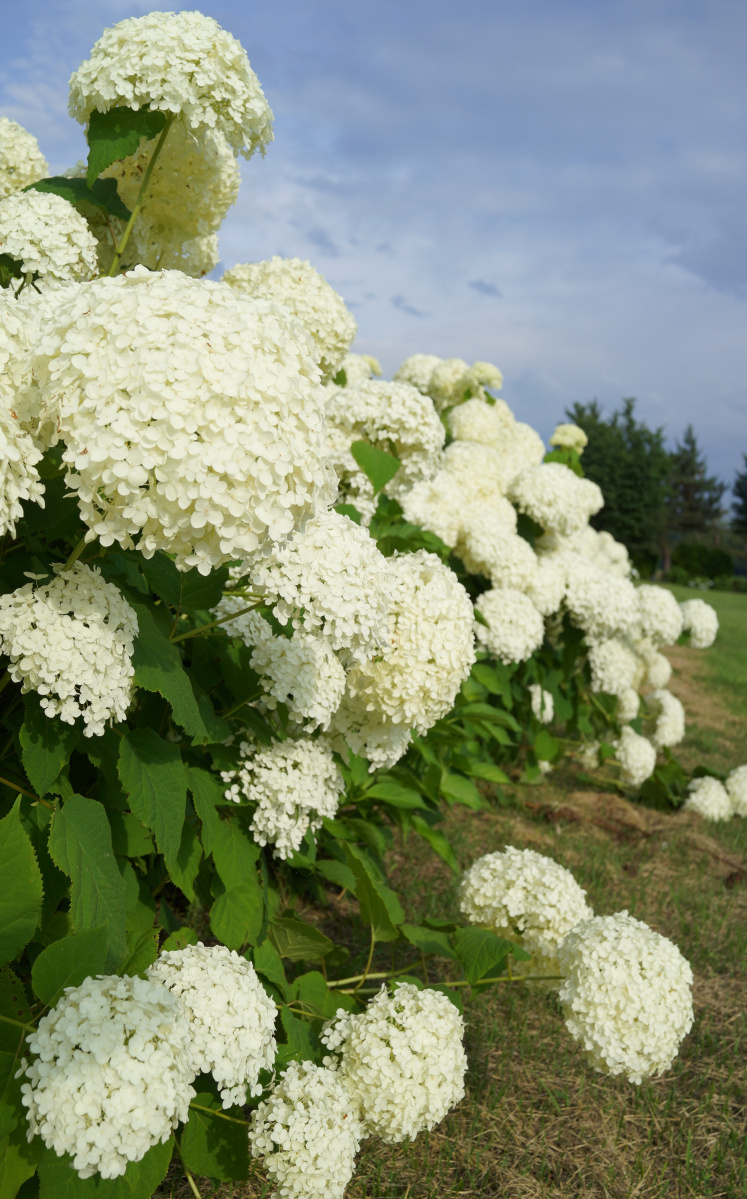The second most frequent question I get from gardeners – when I see them in person or they email me – is “Why aren’t my hydrangeas blooming?
I’ve had a fairly good answer over the years, but decided to get some support from Andi Ross, founder of It’s Nature’s Way landscape-design company on Plum Island in Massachusetts. Her topic at the Maine Flower Show in March was native hydrangeas, but the first part of her talk encompassed non-natives, too.
There are 76 species of hydrangeas, according to Ross, far more than I know about, and every part of the world has some native hydrangeas. The shrubs have existed for a long time. Really long. Hydrangea Alaskana was discovered in the 1920s – it’s a fossil that dates back 23 million years.
The most important thing that Ross said is true no matter the variety: “You don’t need to prune hydrangeas. They are not perennials, and need woody stocks to be healthy. They can be pruned to improve size or shape, or to regenerate them. But if a hydrangea needs to be pruned repeatedly, it is in the wrong spot.”
Often, the reason that hydrangeas don’t bloom is that people have cut off the flower buds during improper pruning.
The first thing to know is that all hydrangeas (and almost all shrubs) should be pruned one branch at a time – not with hedge trimmers or chain saws or weed wackers. Also, it’s useful to know that some hydrangeas bloom on old wood, which means they form flower buds in the fall. If people follow the standard rule of pruning in midwinter when the bush is dormant, they will be cutting off blossoms.
Hydrangeas that bloom on old wood are oakleaf (quercifolia), big leaf (macrophylla), mountain (serrata) and the climbing vine (anomala petiolaris). The vine you wouldn’t prune anyway unless it starts to grow into your garage through your garage door. Mountain hydrangea is fairly new to the market and should stay small, so you won’t have to worry about pruning that.
The big-leaf hydrangeas are the ones that can be blue. The “Endless Summer” varieties are supposed to bloom on both old and new wood, but they have not done well in Maine. And they aren’t native.
In addition to improper pruning, other reasons hydrangeas don’t blossom is that they don’t get enough water and they don’t get enough sun. They need at least four hours of sun a day – depending on the variety – although a few varieties will take less. The roots of the word are “hydra,” which in Greek means water, and “angeion,” which in Greek means vessel, Ross said. Hydrangea need to be well watered, at the roots not on the leaves, for several years after planting.
In her talk, Ross gave one other reason that explains why your hydrangeas may not be blooming: High-nitrogen chemical fertilizers promotes the growth of leaves, and discourages blossoms, she said. Don’t fertilize them heavily, and if your lawn is regularly fertilized, keep the hydrangeas away from the lawn or the lawn fertilizer away from the hydrangea garden.
Now, to the natives.
Hydrangea arborescens, or smooth-leaf hydrangea, is one of the most reliable bloomers.
The cultivar that has been around longest is “Annabelle”; my wife and I have had it in our yard for 40 years and each and every one of those years, it has reliably given us pure white blossoms.
“The problem with ‘Annabelle’ ?” Ross asked. The audience knew the answer to this one and said so in unison: “It flops.”
The weight of the big white blossoms can pull down the branches, which then lean over and touch the ground.
Breeders have developed “Incrediball” to have stronger stems, and as a side benefit it has larger blossoms, too. “Invincibelle Spirit II” has pink blossoms, while Seaside Serenade “Bar Harbor” is more compact than “Annabelle” and has sturdier stems.
Another advantage is that some of the Arborscens hydrangeas (“Invincibelle Spirit II,” “Invincibelle Mini Mauvette” and “Bar Harbor”) can tolerate full shade.
These are the most reliable bloomers in the hydrangea family.
Hydrangea quercifolia, or oakleaf hydrangeas, are the other New England natives. They have attractive leaves that, as their name implies, look like oak leaves. These leaves turn a beautiful pink and burgundy color in the fall, and the peeling bark looks good in winter. Oak leaf hydrangea blossoms can be gorgeous, and Ross has good luck with them in Massachusetts – where it is warmer.
The O’Donal’s catalog, however, offers this warning: “Flowers, when they form in the New England climate, are extremely large cones of lace-like blooms that open cream and change to pink. Because of potential winter injury to bud-forming stems, oakleaf hydrangea is usually used here as a foliage plant, especially since the foliage turns a spectacular burgundy red.”
In sum, know what you are purchasing. I’ll stick with “Annabelle” for now.
Wondering what the most common question I get is? It’s this: “What is that black growth on my maple leaves?”
That is tar spot of maple, a fungus that produces black spots on maple leaves. It looks exactly as though someone spattered tar on a maple leaf – easy to identify. In Maine, it appears most commonly on Norway maples, an invasive species that is now illegal to sell here. It will occasionally appear on native maples, such as sugar maple and red maple, but is not as prevalent.
While tar spot is ugly, it doesn’t cause any serious health problems for the trees – which, in the case of the Norway maple, is unfortunate.
TOM ATWELL is a freelance writer gardening in Cape Elizabeth. He can be contacted at: tomatwell@me.com.
Send questions/comments to the editors.


